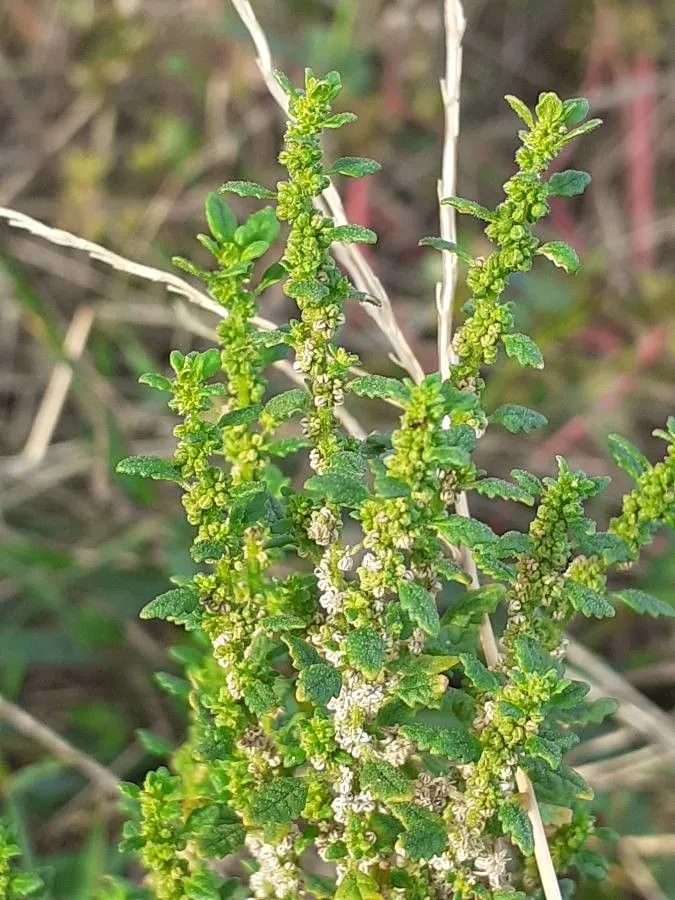
Author: (R.Br.) Mosyakin & Clemants
Bibliography: Ukrayins’k. Bot. Zhurn. 59: 382 (2002)
Year: 2002
Status: accepted
Rank: species
Genus: Dysphania
Vegetable: Unknown
Observations: Australia
Clammy goosefoot, scientifically referred to as Dysphania pumilio, is a distinctive member of the Amaranthaceae family. This intriguing species was detailed in a botanical overview published in the “Ukrayins’k. Bot. Zhurn.” journal in 2002. The nomenclature, as credited to (R.Br.) Mosyakin & Clemants, sheds light on its well-rooted scientific lineage.
Endemic to Australia, clammy goosefoot thrives across a diverse range of environments, demonstrating its resilient nature. This plant is known for its peculiar sticky texture, a characteristic that likely influenced its common name. As a member of the Amaranthaceae family, it shares familial traits with other well-adapted flora found in similarly challenging habitats.
The botanical characteristics of Dysphania pumilio have sparked interest among botanists and plant enthusiasts alike, due in part to its unique adaptation mechanisms and its contribution to the ecological fabric of its native landscape. Through studies and observations, particularly those documented in the early 21st century, a greater understanding of its role within the ecosystem has emerged.
Clammy goosefoot stands as a testament to the diversity and adaptability of plant life within Australia’s rich botanical heritage. The detailed scientific work conducted by experts like Mosyakin & Clemants continues to inform and inspire ongoing research, ensuring that the legacy and understanding of Dysphania pumilio are preserved and expanded for future generations.
Deu: australischer drüsengänsefuß
Eng: clammy goosefoot, small crumbweed, australian goosefoot, ridged goosefoot
Dan: dværg-gåsefod
Nld: liggende ganzenvoet
Fra: chénopode couché
Swe: pygmémålla
En: Clammy goosefoot, Small crumbweed, Australian goosefoot, Ridged goosefoot
Da: Dværg-gåsefod
Nl: Liggende ganzenvoet, Liggende Ganzevoet
Fr: Chénopode couché
De: Australischer Drüsengänsefuß, Autralischer Gänsefuß
Sv: Pygmémålla
Taken Jan 11, 2021 by Grotaers Heidi (cc-by-sa)
Taken Oct 11, 2021 by Feya Sterling (cc-by-sa)
Taken Feb 5, 2022 by Kozie WithA-K (cc-by-sa)
Taken Oct 5, 2020 by Prieta Javier (cc-by-sa)
Taken Oct 5, 2021 by Feya Sterling (cc-by-sa)
Taken Aug 15, 2022 by Carmelo Zerbo (cc-by-sa)
Taken Sep 15, 2004 by Photoflora – Jean-Luc TASSET (©)
Taken Sep 30, 2021 by Llandrich anna (cc-by-sa)
Taken Aug 28, 2012 by Tela Botanica − Hugues TINGUY (cc-by-sa)
Taken Oct 5, 2020 by Prieta Javier (cc-by-sa)
Taken Jul 26, 2021 by Feya Sterling (cc-by-sa)
Taken Oct 17, 2022 by Patrick Nard (cc-by-sa)
Taken Sep 24, 1999 by Tela Botanica − Liliane Roubaudi (cc-by-sa)
Taken Sep 15, 2004 by Photoflora – Benoit BOCK (©)
Taken Sep 30, 2021 by Llandrich anna (cc-by-sa)
Taken Aug 28, 2012 by Tela Botanica − Hugues TINGUY (cc-by-sa)
Taken Aug 28, 2012 by Tela Botanica − Hugues TINGUY (cc-by-sa)
Taken Aug 28, 2012 by Tela Botanica − Hugues TINGUY (cc-by-sa)
Taken Aug 13, 2016 by Tela Botanica − Fernand ORSINI (cc-by-sa)
Taken Sep 30, 2021 by Llandrich anna (cc-by-sa)
Taken Sep 26, 2022 by Jean-François Baudin (cc-by-sa)
Taken Aug 10, 2022 by Valentina Jalšovec (cc-by-sa)
Taken Oct 15, 2008 by Photoflora – Jean-Luc TASSET (©)
Taken Aug 15, 2008 by Photoflora – Jean-Luc TASSET (©)
Taken Aug 15, 2008 by Photoflora – Jean-Luc TASSET (©)
Taken Aug 15, 2012 by Photoflora – Jean-Luc TASSET (©)
Taken Sep 15, 2009 by Photoflora – Benoit BOCK (©)
© copyright of the Board of Trustees of the Royal Botanic Gardens, Kew.
© copyright of the Board of Trustees of the Royal Botanic Gardens, Kew.
Family: Myrtaceae Author: (F.Muell.) K.D.Hill & L.A.S.Johnson Bibliography: Telopea 6: 402 (1995) Year: 1995 Status:…
Family: Rubiaceae Author: Pierre ex A.Froehner Bibliography: Notizbl. Bot. Gart. Berlin-Dahlem 1: 237 (1897) Year:…
Family: Sapindaceae Author: Koidz. Bibliography: J. Coll. Sci. Imp. Univ. Tokyo 32(1): 38 (1911) Year:…
Family: Asteraceae Author: A.Gray Bibliography: Pacif. Railr. Rep.: 107 (1857) Year: 1857 Status: accepted Rank:…
Family: Fabaceae Author: Medik. Bibliography: Vorles. Churpfälz. Phys.-Ökon. Ges. 2: 398 (1787) Year: 1787 Status:…
Family: Aspleniaceae Author: (Cav.) Alston Bibliography: Bull. Misc. Inform. Kew 1932: 309 (1932) Year: 1932…